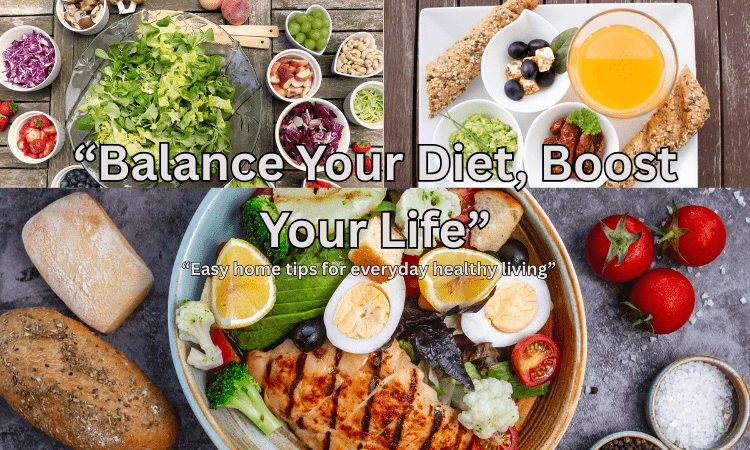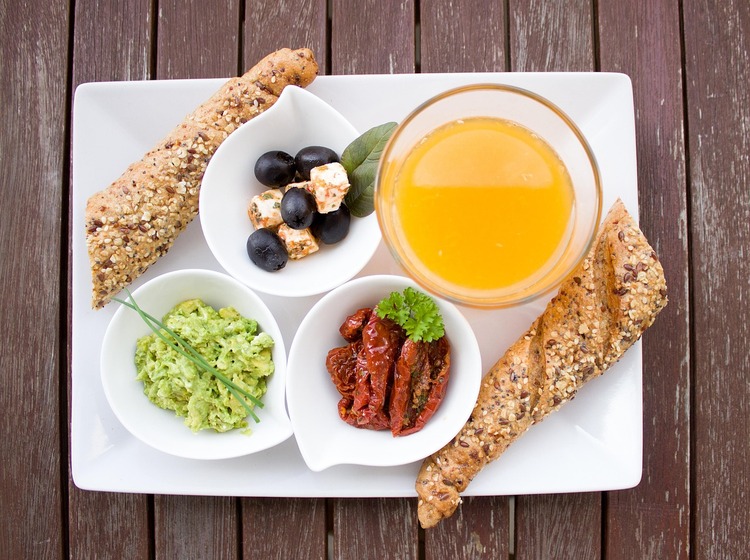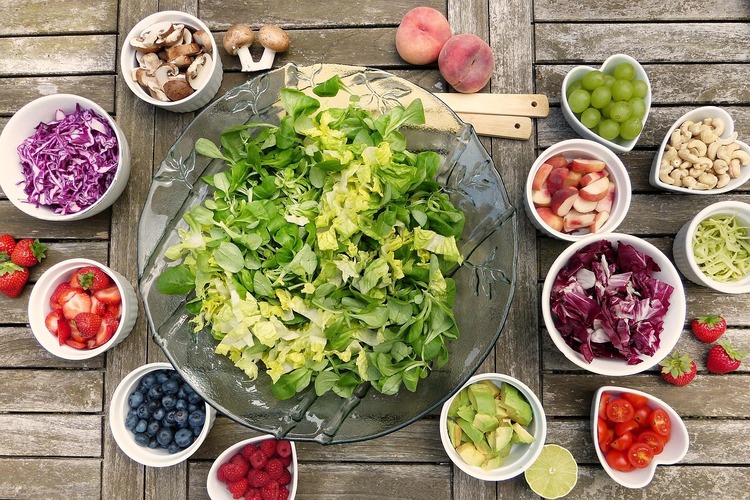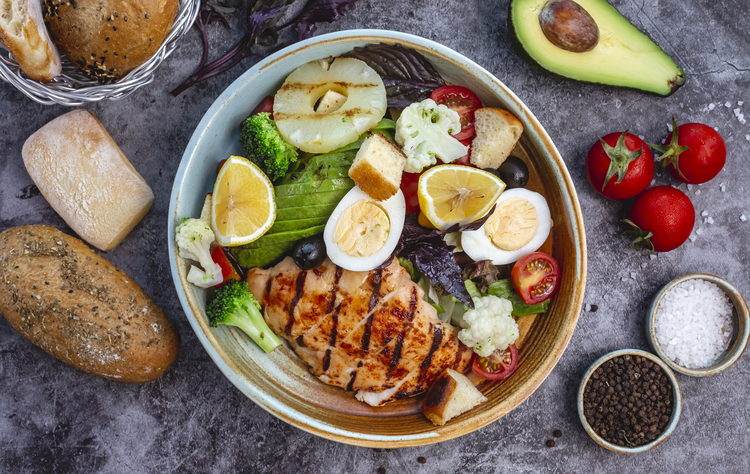
Maintaining a balanced diet at home doesn’t have to be complicated or expensive. With the right knowledge and a few mindful choices, anyone can build healthy eating habits that last. This guide will show you how to balance diet at home with simple, practical steps backed by expert recommendations.
What Is a Balanced Diet?
A balanced diet means giving your body all the essential nutrients — carbohydrates, proteins, fats, vitamins, minerals, and water — in the right proportions.
According to the World Health Organization (WHO), adults should eat at least five servings of fruits and vegetables each day to reduce the risk of chronic diseases and improve overall well-being.
A good mix of food groups might look like:
- Carbohydrates: whole grains, brown rice, oats
- Proteins: lentils, eggs, tofu, fish
- Healthy fats: nuts, olive oil, seeds
- Fruits & vegetables: colorful options for vitamins and fiber
1. Plan Your Meals Ahead of Time

Meal planning is one of the easiest ways to stay consistent with healthy eating. When you plan your meals, you avoid random snacking and overeating.
Example Plan:
- Breakfast: Oatmeal with banana and nuts
- Lunch: Brown rice, mixed vegetables, and grilled paneer or chicken
- Dinner: Vegetable soup or salad with quinoa
Try This Today: Write down your meals for tomorrow — it takes five minutes but keeps you on track.
2. Add More Fruits and Vegetables

Fruits and vegetables are rich in vitamins, minerals, and antioxidants that protect your body from disease.
A 2023 Harvard Health study found that people who eat a variety of fruits and vegetables daily have a 13% lower risk of heart disease.
Action Tip:
- Fill half your plate with vegetables or salad at every meal.
- Include seasonal fruits like apples, papayas, or berries.
Try This Today: Add one extra serving of fruit to your lunch or dinner.
3. Stay Hydrated Throughout the Day

Water plays a key role in digestion, metabolism, and detoxification.
The National Academies of Sciences recommends about 3.7 liters for men and 2.7 liters for women per day, including fluids from food.
Simple Ways to Stay Hydrated:
- Keep a water bottle on your desk.
- Drink a glass before every meal.
- Replace one sugary drink with water or herbal tea.
Try This Today: Set a reminder to drink a glass of water every 2 hours.
4. Choose Whole Grains Over Refined Ones
Refined grains like white bread or pasta lose fiber and nutrients during processing. Whole grains, on the other hand, keep you full longer and support digestion.
Examples: Brown rice, oats, whole wheat roti, quinoa, and barley.
Try This Today: Swap one refined grain (like white rice) for a whole-grain option at your next meal.
5. Include Protein in Every Meal

Protein helps repair tissues, build muscles, and maintain energy. Most people underestimate their protein needs.
According to the Indian Council of Medical Research (ICMR), adults should consume about 0.8–1.0 grams of protein per kilogram of body weight daily.
Protein-Rich Foods:
- Vegetarian: Lentils, beans, soy, paneer, nuts
- Non-vegetarian: Chicken, fish, eggs
Try This Today: Add a protein source to your breakfast — boiled eggs, Greek yogurt, or sprouts.
6. Limit Sugar and Processed Foods
Processed snacks and sugary drinks can lead to weight gain, fatigue, and poor digestion.
Instead of cutting everything at once, focus on gradual swaps.
Healthier Alternatives:
- Fresh fruits instead of desserts
- Roasted chickpeas instead of chips
- Smoothies instead of soda
Try This Today: Avoid packaged snacks for one full day and replace them with natural options.
7. Control Portions and Eat Mindfully
Even healthy foods can cause issues if you overeat. Use smaller plates and chew slowly to give your body time to feel full.
Action Steps:
- Avoid distractions like TV while eating.
- Stop eating when you feel 80% full.
Try This Today: Use a smaller bowl or plate for dinner and notice how quickly you feel satisfied.
8. Combine Balanced Diet with Active Living
Diet alone can’t make you healthy — it works best with an active lifestyle.
Include at least 30 minutes of physical activity daily, whether it’s walking, yoga, or cycling. Sleep well and manage stress through mindfulness or journaling.
Try This Today: Take a 10-minute walk after lunch or dinner — it helps digestion and boosts mood.
Final Thoughts: Start Small, Stay Consistent
Learning how to balance diet at home isn’t about perfection — it’s about progress.
Start with one small change today: swap a sugary drink for water or add a fruit to your breakfast. Within a week, you’ll notice a real difference in your energy and focus.
Healthy living starts at home — and your kitchen is the best place to begin.
📝 Frequently Asked Questions (FAQs)
1. What is the best way to balance diet at home?
The best way to balance your diet at home is to include all essential nutrients — carbohydrates, proteins, healthy fats, vitamins, and minerals — in the right portions. Focus on whole grains, fresh fruits, vegetables, and protein-rich foods while limiting processed and sugary items.
2. How can I plan a balanced diet without spending too much money?
You can maintain a healthy diet on a budget by choosing local and seasonal fruits and vegetables, buying in bulk, cooking at home, and reducing takeout meals. Simple foods like lentils, eggs, oats, and brown rice are both affordable and nutritious.
3. What are the signs of an unbalanced diet?
Common signs include fatigue, frequent hunger, weak immunity, poor digestion, and unhealthy weight gain or loss. If you often feel tired or experience mood swings, your diet may lack essential nutrients like protein, fiber, or vitamins.
4. How much water should I drink daily for a balanced diet?
The National Academies of Sciences recommends about 3.7 liters for men and 2.7 liters for women per day, including fluids from foods. Proper hydration supports digestion, metabolism, and overall health.
5. Can I follow a balanced diet if I’m vegetarian?
Absolutely. A vegetarian diet can be well-balanced by including lentils, beans, tofu, paneer, nuts, seeds, and whole grains. Pairing plant-based proteins with iron-rich foods like spinach or citrus fruits improves nutrient absorption.